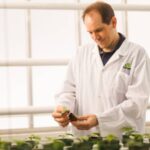
Celebrate Lavender!
Each year, the National Garden Bureau recognizes specific plant species as part of its “Year of” program. In annuals, 2020 is the Year of the Lantana. You can read more about this crop in the January 2020 issue of GPN. This month, we’re chatting with industry insiders on the NGB’s choice in perennials for 2020: lavender.
Lavender boasts many positive attributes: it is striking in the garden, provides a lovely scent, can be used in culinary applications, and attracts bees and other pollinators. What’s not to love about lavender?
I got to pick the brains of a few industry members to see what they had to say about developments in lavender and how growers can capitalize on this trending crop. Here’s what they had to say.
GPN: Are you familiar with the National Garden Bureau’s “Year of” program? Do you take advantage of and promote the selected crops when they pertain to your business?
Jim Devereux, Green Fuse Botanicals: Absolutely! It is a strong promotional tool to provide focus to certain genus where we not only have the opportunity for sales, but also to educate our ultimate customer.

Lloyd Traven, Peace Tree Farm: Yes, we do. We follow anything that allows us to market a product as “extra special,” and we look to Perennial of the Year from PPA and all the NGB-AAS selections, as well as prominent magazines. Additionally, we try to attend CAST and are looking for unusual and unique plants to emphasize, NOT the typical new pink petunia, because, you know … petunias.
April Herring-Murray, Pacific Plug & Liner: We have not in the past because the products selected were not crops we focus on, but we plan to take advantage of the 2020 program for lavender since it is one of our top programs at PP&L.
GPN: 2020 has been named “Year of the Lavender.” In your opinion, why do you think this crop was selected for the upcoming year?
April: Lavender is a super popular plant that is a perennial and herb, and has multiple uses: in the garden, cut flowers, in cooking, in the home and medicinal.
Lloyd: Lavender has been exhibiting solid double-digit increases EVERY year since 2014, and it is the largest selling perennial worldwide. Some of this is due to the fact that it is an actual field crop as well as ornamental, but it surely is worthy of recognition. This dramatic repetitive increase is directly timed with the introduction of a true game-changing variety, lavender ‘Phenomenal’.
Jim: Lavender is a staple for the floriculture industry. It crosses multiple segments for the consumer in viable ornamental, aromatic, medicinal and culinary applications. It is also one of the most easily recognizable plants on the retail level, but many consumers are not fully aware of the breeding scope and commercial importance.
GPN: What has been your role and experience in the development, marketing and/or sale of lavender?
April: In working with multiple breeders, we have developed a lavender

program that includes over 75 varieties of English, Spanish and Intermedia types from both cutting and seed. We also use the great Mediterranean climate of central California to produce well-branched hardened liners for best grower success in finishing a lavender crop. To evaluate differences between varieties, we have done several comparison trials with results being on display at California Spring Trials. Just by promoting lavender as a program and highlighting unique varieties we have seen our lavender sales increase each year since starting the promotion.
Jim: I work with independent breeders throughout the globe to trial and bring new varieties to market that suit North America. I am also in charge of domestic stock production of lavender in order to get it to customers as quickly as possible to avoid ethylene damage. We trial not only for habit but also earliness and flower form. In 2018, we brought the first ever multibract lavender to the market.
Lloyd: Peace Tree Farm introduced lavender ‘Phenomenal’ in 2014, and this variety changed everything! For the first time, consumers could actually start to depend on a lavender surviving in the landscape — and it survived and thrived in the deep South as well as the cold North. It tolerates high heat and humidity and has survived in Minnesota, Canada, and places between. Perhaps more crucial, though, it was a true production plant for growers, too! Uniform, drought resistant, it simply survives and sells — the constant refrain we hear that they couldn’t keep it in stock, and were increasing. It is a variety that consumers come into stores and ask for by name, and this is due to our marketing it directly to consumers, as well as retailers and growers.
GPN: What changes and innovations have you seen in recent years in the lavender category?
April: The biggest change has been in the development of English types that no longer need vernalization to bloom. So now growers can produce English lavender in one season and can also spread the crops out with different planting times for a longer selling season.
Jim: Lavender has typically been a long day plant or later to bloom in the season, meaning the height of the bloom is aft er the main retail season. Breeding for earliness or neutrality has been influential in positioning lavender for prime time sales.
Lloyd: There has been increasing breeding and introduction of new patented angustifolias, and they are great improvements over the old standby varieties like ‘Munstead’ and ‘Hidcote’. Better cold hardiness, reblooming, larger flowers, and early blooming are among the advantages, as well as clean stock and uniformity for growers — but the real difference is that the cultivars are clearly a big improvement over the old varieties.
GPN: How can growers capitalize on lavender?
Jim: Ummm … grow it? Year-round lavender programs are the best avenue as the indoor applications may be just as large as the outdoor. Keeping the pot crop mentality in mind on lavender will greatly expand the unit potential.
April: Grow lavender year round. Look at selling lavender not just as a perennial but also as an indoor gift item, especially during the sale windows when lavender is not selling as a perennial.
Lloyd: Grow more, but change to better plants — because WHY would you offer an inferior product? It is water friendly, perennial, aromatic even when not in bloom, there are proven health benefits, and attractive foliage. Offer allied products — oils, sachets, cut flowers, crafted products. Offer it all year, too — it is truly not only about the bloom, unlike annuals and most typical perennials. It can even be a topiary for Christmas.

GPN: What are some new/unique/special recent lavender introductions? What are their characteristics?
April: New Spanish Lavenders with extra-large flags (Javelin, Madrid, ‘Evergreat Blue’) and double flowers (Madrid Lavish) are real attention getters at retail.
Lloyd: Lavender ‘Phenomenal’ truly set the stage for this renaissance of lavender! There is simply nothing else in the intermedias like it. Among the angustifolias (English lavender), notable introductions recently are ‘Big Time Blue’ (very large color saturated flowers) and ‘SuperBlue’ (extremely early and extremely hardy). Among tender lavenders, there is an oversaturation of stoechas lavenders (Spanish) — lots of color, but the fragrance is not good, and they are not hardy in most areas — although they are good in places like California. There are some amazing selections, though, particularly from Green Fuse, and a stunning double flowered selection. There are a couple variegated selections, too. ‘Meerlo’ is a tender type with good variegation, and ‘Platinum Blonde’ is a good variegated novelty hardy lavender.
Jim: Green Fuse has introduced the first ever fully double lavender stoechas in the Lavish series. This unique bract of false flowers gives consumers five to six weeks of color per flower while also delivering the earliest to initiate blooms on the market.

GPN: Is there anything in the pipeline in the lavender category that you can share?
Jim: We will introduce the first bicolor lavender stoechas in 2020.
April: We are working with a few breeders on some new selections, which we hope to showcase at California Spring Trials. Come by and visit March 28 through April 1 to see what we have cooking!

Lloyd: Yes, yes, YES! Peace Tree Farm is introducing a new intermedia, derived from lavender ‘Phenomenal’, that shows flowers three to four times thicker on branched stems, incredible stem strength, silver white summer foliage, a broader thicker leaf and more compact habit. It is a dramatic improvement in structure for cut flower use, as thick as a veronica. It will come out in limited offering in 2020 (look for it at Cultivate), and full distribution in 2021. It will stun you.
GPN: What makes lavender especially appealing to consumers?
Lloyd: FRAGRANCE, and health and wellness benefits. Water-friendly, and does well in depleted alkaline soils in full harsh sun. Evergreen foliage, and a plant that can make a great hedge that blooms. Calming and beautiful and useable for a wide assortment of purposes, and it is edible. You should try it in cookies, on fish, in beer and VODKA.
April: Mostly the smell, which is very calming and relaxing. But also due to the many ways that it can be used, not only is it beautiful for the garden but it can provide health and medical benefits, and, because of incorporation into so many products like soaps and perfumes, consumers have a high level of familiarity with it.
Jim: All consumers like to be able to name or recognize a plant at the retail level. Lavender is far easier to do this, as every aspect of the plant is able to pull on the five senses. The beauty of the flowers, the scent of the foliage, the texture of the leaf kindly relay memories.









 Video Library
Video Library 


















